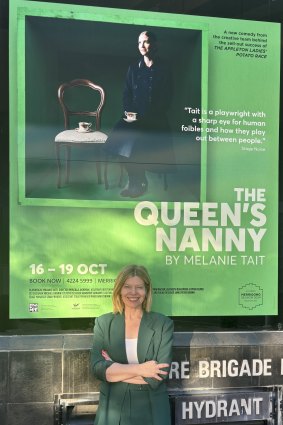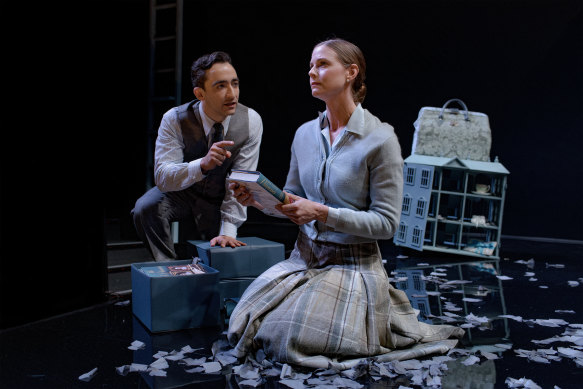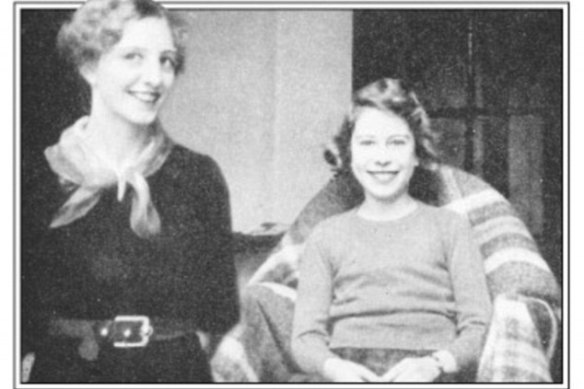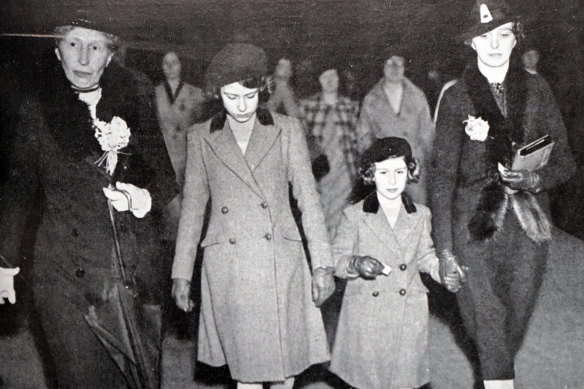This was published 6 months ago
Opinion
The most moving story about the Queen you’ve never heard but must see
Peter FitzSimons
Columnist and authorMelanie Tait is the playwright behind The Queen’s Nanny, which has just finished at the Ensemble Theatre and will next year be going on a national tour.

Melanie Tait outside the Ensemble Theatre.
Fitz: Melanie, congratulations. I don’t want to sound like a gushing fanboy, and will soon try and resume normal programming by being a grizzled cynic, but I saw your play a fortnight ago and was stunned. What a story, what absorbing theatre, what a wonderful piece of work by you!
MT: Thank you so much for all of that, you’ve just made my day. I’m absolutely thrilled.
Fitz: Well, I mean it, and I may as well put up front for the readers that I approach this as someone who went along reluctantly but came away buzzing. Completely independent of anyone’s republican/monarchist fervour, it is such an amazing story, so moving, and all of it true.
MT: Isn’t that the thing? The story! The primary reaction of theatregoers is they then go and find out about the actual story, and confirm it all happened. And it really affects people, particularly those who’ve had nannies, or been nannies, because it’s rare that everyone feels completely satisfied in that sort of triangle between child, mother and nanny – and often somebody feels like they’re missing out. So we’ve had a lot of that, and we’ve just had a lot of people as well who just really love the theatricality of it and the exciting way that the story is told.

A scene from The Queen’s Nanny. Credit: Phil Erbacher
Fitz: Let’s get to that extraordinary story. Think of me as a Hollywood mogul complete with cigar. Tell me and sell me the story, but start with how you came across it.
MT: Well, I am embarrassed to admit I’m a bit of an amateur scholar of the royal family. If I was on Mastermind or something, they’d be my topic. And so I’ve always kind of known about the story, and then I read Tina Brown’s brilliant Palace Papers a few years ago, and there’s a whole chapter about staff in it, and it reminded me of that original story. And I thought, God, that is just perfect for a play!
Fitz: Enter, stage left, a young woman by the name of Marion Crawford. Our scene is set in, what, the early 1930s? And Buckingham Palace?
MT: Yes, and she is forthright and getting well educated, filled with chutzpah and ambition, training to be a child psychologist – wanting to go and teach in the Glasgow tenements and help raise kids up, educate them and give them better lives. And while on holiday she gets, by pure chance, this temporary babysitting job with the royal family. A working-class Scottish girl! Elizabeth is just five years old. They all love her, and say “come and work with us as our governess!” Though she tries to get back to college to finish her degree – and actually makes a move to go a dozen times – the woman we now know as the “Queen Mother” kept on coming up with reasons for why she couldn’t go just yet, and she ends up staying for 17 years, until Princess Margaret comes of age.

Marion Crawford and her dear Lilibet.
Fitz: And through that time, she has this extraordinary, nigh maternal relationship with Elizabeth, helping to form her character and perhaps even giving her a dose of feminism – and the idea that, as a royal, she could do more than just go to garden parties.
MT: It would have been less feminism as a taught thing, and more by example of “Crawfie’s” own independent way. But, yes, and added to that would be the sense of Scottish Presbyterian duty, devotion to doing what you say you’re going to do, acting with integrity, working hard, all of that kind of stuff. I feel a lot of that came from Crawfie.
Fitz: And they become more like mother and daughter, despite the gulf in their “class”. So, with the girls coming of age, what happens when the royals no longer need a nanny?
MT: Well, she’s given a grace-and-favour cottage at Kensington Palace, the same Nottingham Cottage that Harry and Meghan were given at the start of their marriage. It’s a tiny little dump. And so at the age of 38, she’s put in there with her husband – she had only been able to finally marry after leaving, and by that stage it was too late for her to have her own children – and all her neighbours are old royals, old staff members, and some very dull people.
Fitz: Wait! One evening while the nanny is with her manny, at home, I can hear a knock on the door! It is a tall, dark stranger. Can he have a word?
MT: Yes, the Foreign Office had approached the Queen Mother, wanting to organise some positive PR in America because they wanted the Americans to feel closer to Britain, so that unlike the two previous world wars, they wouldn’t take as long to engage in any future war. The idea was to do some stories in the American press about the princesses. Everyone had said, “If you want to write about the princesses, you need to talk to Crawfie because she would have all the stories of the young girls growing up”. And so Crawfie told all the stories to a ghostwriter, for a book by her.

Princess Elizabeth and Princess Margaret with Lady Helen Graham and Marion Crawford after their first ride on the Underground Rail.Credit: Universal Images Group via Getty Images
Fitz: Which brings us to the key question of whether she did it with the royal family’s blessing or not?
MT: Here’s where it gets kind of muddy. There’s a letter where the Queen Mother basically says: “We’re fine with you doing it and being paid. Just don’t use your name.” So, Crawfie goes ahead with the book. The stories she told were harmless and showed the royal family as such a delightful bunch – she was so loyal to them. You know, she’d basically raised these two little girls, and “Lilibet” – particularly – was the love of her life. She didn’t want to do anything that would jeopardise that relationship or hurt it, but it didn’t make sense to leave her name off it, because that is what gave the stories credibility. So she thought that when the Queen Mother read the book, she’d be fine with it. But she wasn’t.
Fitz: Alas …
MT: Yes, alas. Crawfie was iced out of royal circles for the rest of her life. She’s never officially kicked out of her cottage, but she was made to feel very unwelcome. No one came by anymore. No one sent her Christmas cards. No more visits by her cherished princesses.
Fitz: Cast into outer darkness, but still she doesn’t give up hope of seeing Lilibet again – who by now has become the Queen.
MT: Yes. It is all she wants. So she buys a cottage by the only road from Aberdeen to Balmoral Castle, and for the rest of her life whenever the Queen is in residence, she stands in her cottage, gazing out the huge window visible from the road, hoping that one day her Lilibet will call in. But as the record shows, or at least as the official record shows … she never does.
Fitz: Oh, Crawfie! Dear God, the agony of it. If you were to choose one emotion that Crawfie would have had as she sat in that window and watched the Queen go by – year, after year, after year – what emotion would you pick - anger, sadness, hope?
MT: Heartbreak. Sheer heartbreak every time she did but see her passing by, and not stopping. It is all just so sad, and moving. Not only did Crawfie devote those 17 years to the two princesses, but she sacrificed her own possibility of having children of her own – and then never saw the two princesses she did raise again. Tragically, she tried to commit suicide after she lost her husband in the late 70s, leaving a note along the lines of, “I can’t bear to see those I love pass me by on the road.”

The window Crawfie sat in to watch the Queen pass by.
Fitz: Crawfie! Would royal historians accept that even this detail of this story is true?
MT: Broadly, yes. The belief is that the Queen didn’t ever drop in to say hello to her on her way to Balmoral Castle, that the Queen never spoke to Crawfie again, and neither did Margaret. Crawfie died in 1988, alone.
Fitz: But it is not just Crawfie I feel sorry for in this sad story, but also the Queen and Princess Margaret. The pathos of it all. And it really was surely horrible for the Queen – who must have known the right thing to do, and must have wanted to see her, but personal duty and desire was trumped by royal duties. Crawfie had to be made an example of. For all. Who talks is done. All those forces placed upon you, getting in the way of normal human interaction. All the carry-on, and you can’t even see those you love.
MT: I don’t know about that. After seeing the play, a lot of people say, like you: “The Queen had no choice. It was her duty.” And I say that’s bunkum – she was the Queen. She can literally do what she wants. But she didn’t. She forgave Fergie for the toe-sucking, and forgave Andrew for the Epstein scandal, but couldn’t forgive Crawfie for putting her name to the book that made Lilibet look great, that the Queen Mother had ostensibly given her permission to write. And had done so because the Foreign Office felt it would help Britain win the next war! The Queen should have seen her.
Fitz: I am going to tell the Australian Monarchist League what you just said, and you will be in BIG trouble. Moving on, I was stunned by how cleverly you put the play together. How does one even begin to write a play?
MT: I researched the story for two years, travelled to England and Scotland and began jotting different scenes in my notebook. I always knew I had to start and finish with Crawfie gazing out the window, and I also knew I would have to have several actors filling many roles – and we ended up with three actors to play a dozen roles, to make it more interesting. We went from there, splicing the scenes together and working out how to tell it.
Fitz: Did you uncover fresh insights in your research?
MT: Certainly. And it turned out Crawfie was born about 15 minutes from where my Scottish family still live. So I felt like I had an understanding of the kind of person that she was. And as I am also a woman who doesn’t have children ...
Fitz: Are you really one of those “childless cat ladies” I have heard about, wrecking the joint?
MT: [Laughing] Speaking! But it means I am very close to my own niece, Molly – who I am obsessed with, just as she is obsessed with me. That meant I felt like I could channel a lot of Crawfie’s emotions as the Queen passed by. I cannot imagine the agony if Molly ever did that to me, but I tried to capture that in the play.
Fitz: Well, you did. And I wish you, and Molly, all the best.